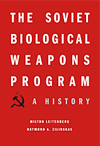Research
- Emerging technologies, such as synthetic biology and nanobiotechnology, and their security, governance and misuse prevention
- Weapons programs (e.g., the USSR, Iran, Iraq) via interviews with the weaponeers, key officials, and inspectors or primary source documentation
- Potential development of warfare agents
- Constructive roles of nontraditional players, such as the private sector, in nonproliferation
- Dialogues with stakeholders in troubled countries & regions
- International arms control & disarmament developments
- Public health systems and catastrophic events preparation for state, county, and other local health departments
- Biological cooperative threat reduction activities in the former Soviet Union & new developments in the Middle East, Asia, and Africa
- Proliferation potential of the anti-plague systems of the former Soviet states & possible benefits to international public health
Training
Courses
- Semester-long seminar: chemical and biological weapons & arms control
- Short, intensive workshops: technologies, export controls, WMD destruction, nonproliferation, disarmament, and terrorism
- Specific courses: Introduction to Weapons of Mass Destruction Nonproliferation, Export Controls, Terrorism Involving Weapons of Mass Destruction, & regionally-focused courses
Community Involvement
CBWNP liaises with both local and regional law enforcement officials to increase local knowledge about chemical & biological weapons and WMD terrorism. Staff members also work with public health and emergency response professionals on these issues.
Conferences
Staff members provide guest lectures and participate in conferences that address biological and chemical warfare.
Activities

Book
The Soviet Biological Weapon Program: A History
The book contains the published findings from the research project, Studies of the Anti-plague System in the Former Soviet Union and Its Successor Nations.
From the publisher:
 “Based on interviews with important Soviet scientists and managers, papers from the Soviet Central Committee, and U.S. and U.K. declassified documents, this book peels back layers of lies, to reveal how and why Soviet leaders decided to develop biological weapons, the scientific resources they dedicated to this task, and the multitude of research institutes that applied themselves to its fulfillment. We learn that Biopreparat, an ostensibly civilian organization, was established to manage a top secret program, code-named Ferment, whose objective was to apply genetic engineering to develop strains of pathogenic agents that had never existed in nature. Leitenberg and Zilinskas consider the performance of the U.S. intelligence community in discovering and assessing these activities, and they examine in detail the crucial years 1985 to 1992, when Mikhail Gorbachev’s attempts to put an end to the program were thwarted as they were under Yeltsin.”
“Based on interviews with important Soviet scientists and managers, papers from the Soviet Central Committee, and U.S. and U.K. declassified documents, this book peels back layers of lies, to reveal how and why Soviet leaders decided to develop biological weapons, the scientific resources they dedicated to this task, and the multitude of research institutes that applied themselves to its fulfillment. We learn that Biopreparat, an ostensibly civilian organization, was established to manage a top secret program, code-named Ferment, whose objective was to apply genetic engineering to develop strains of pathogenic agents that had never existed in nature. Leitenberg and Zilinskas consider the performance of the U.S. intelligence community in discovering and assessing these activities, and they examine in detail the crucial years 1985 to 1992, when Mikhail Gorbachev’s attempts to put an end to the program were thwarted as they were under Yeltsin.”
Projects
1. Iraq’s Wars with the US from the Iraqi Perspective: State Security, Weapons of Mass Destruction, Civil-Military Relations, Ethnic Conflict and Political Communication in Baathist Iraq
The project is being conducted to understand and analyze the Iraqi Ba’ath power structure & state system and the Iraqi state from the Iran-Iraq War to 2003. An analysis will be made of WMD proliferation dynamics and the Middle Eastern military and security architecture. The analysis could have applications for understanding other states in the region, particularly Syria.
The project is funded by the U.S. Office of the Secretary of Defense under its Minerva Initiative.
2. Preparedness and Emergency Response (PERRC)
These research findings can be applied by state and local health departments to improve all-hazards preparedness & response to natural and man-made catastrophic events. The PERRC network is constituted by nine academic research consortiums in the United States, including CNS. It also includes CalPREPARE, a consortium comprised of the Center for Infectious Diseases and Emergency Readiness at the School of Public Health, University of California at Berkeley.
Four table-top exercises were conducted simulating biological, chemical, and radiological events perpetrated by terrorists. The exercises were designed by staff and graduate research assistants, in collaboration with the Monterey County Health Department.
The lead investigator for the PERRC project being undertaken at CNS is scientist-in-residence Dr. Ferenc Dalnoki-Veress.
